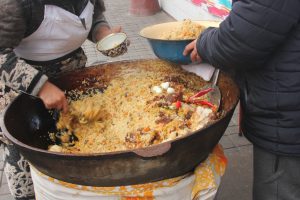A new exhibition at Kyrgyzstan’s National Museum of Art in Bishkek takes on a seemingly quotidian subject: rice. The exhibition, aptly called “Grains of Rice,” will remain on display from February 15 through March 3 and features 80 photographs of a farming community in Batken, Kyrgyzstan’s southernmost province. The exhibition is the result of collaboration between curator Akjibek Beishebaeva and photojournalist Danil Usmanov, who traveled to Batken in the fall of 2021 to observe and document the rice harvest in the village of Myn-Chynar.
Usmanov’s photographs feature striking topographies of rice fields and portraits of villagers gathering rice stalks, mixing grains that have been laid to dry on the road, and haggling over the price of sacks of grain in wholesale bazaars. In addition to viewing the photographs, a tactile component of the exhibition gives museum-goers a chance to touch a bundle of dried rice stalks and gather a handful of dried Batken rice in paper baggies.
While rice is a minor crop in Kyrgyzstan’s broader agricultural portfolio, it is a central component in local cuisine and cultural rites. Plov – a dish made with rice, sliced carrots, and mutton cubes – is scooped from massive cauldrons to feed guests at tois, traditional festivals that include weddings, births, funerals, and religious holidays.
“We all know and love plov,” Beishebaeva told The Diplomat. “But no one knows what stands behind it, how the farmers work and live, what it takes to grow rice.”
Indeed, in farming communities in Batken, rice is not just a pantry staple or cultural symbol; its planting and harvesting determines the rhythm of life. Rice is planted in May, tended throughout the summer, gathered by hand in October, and served at tois through winter and spring. While the short, red grains of Uzgen rice is often heralded as the best grain for plov, Usmanov told The Diplomat that villagers from Myn-Chynar boast about how Uzbekistani tea houses seek out rice specifically from their district. Batken’s economy is more dependent on farming than other provinces, with agriculture accounting for some 40 percent of gross regional product.
As a labor-intensive crop, it is difficult to cultivate rice in sparsely populated Myn-Chynar, Beishebaeva told The Diplomat. Only a few hundred people live in the village, and the population statistics do not reflect the high rates of labor migration in the province. Batken is the most dependent on remittances of Kyrgyzstan’s seven provinces, with some 30 percent of local income made up by money sent from abroad, a rate three times higher than the national average of 12 percent. Even with financial support from abroad, 34 percent of the population lives below the poverty line. Without remittances, Kyrgyzstan’s National Committee on Statistics estimates that number would hover above 50 percent.
In addition to financial difficulties and a lack of opportunities for employment, cross-border conflict makes life in rural Batken quite precarious. While it takes two days to reach Myn-Chynar from Bishkek by car, the village is just a 10 minute drive north from the Sokh enclave belonging to Uzbekistan.
Uncertainty over border demarcation has driven conflict between Kyrgyzstan, Tajikistan, and Uzbekistan — all of which have enclaves in each other’s territories. While the most recent bout of fighting happened in late January left two Tajikistani citizens dead and about a dozen wounded on each side, the most severe conflict in years took place in April 2021. Dozens died, hundreds were injured, and tens of thousands had to flee their homes in both Kyrgyzstan and Tajikistan. Analysts at Bellingcat have argued that climate change – specifically, a decrease in water availability – played a sizable role in the April 2021 conflict.
This nexus of climate change, conflict, and cash-strapped communities contributes to precarity in Batken. Kyrgyzstan’s government and international donors have stepped up efforts to support sustainable development in the province. Even Usmanov’s photography exhibition contributes to a broader development initiative, as part of the “Green Economy Green Economy and Sustainable Development of the Private Sector” project implemented by the German Society for International Cooperation (GIZ) and funded by the governments of Germany and Switzerland.
Unexpected geopolitical events threaten to undermine development projects like this, however. Heavy sanctions imposed on Russia, following its invasion of Ukraine on February 21, are already causing massive economic hardship. The Russian ruble dropped about 30 percent in value from 80 rubles per U.S. dollar to a record low of 106, and bank runs emptied ATMs across the country. Analysts are concerned about the ripple effects for Central Asia’s economies, which are dependent on remittances and heavily tied to the ruble.
Given the intensity of currency panic and cross-border fighting, it is striking that Usmanov’s photographs do not center the violence or fear experienced by communities struggling with the effects of these stressors. Usmanov has captured men smiling as they grab handfuls of plov with their hands, bread stacked in the middle of the table; his photographs show prayer and persistence in action. This representation is an important reminder that even in conditions of extreme precarity, people persist in finding meaning through community.

































